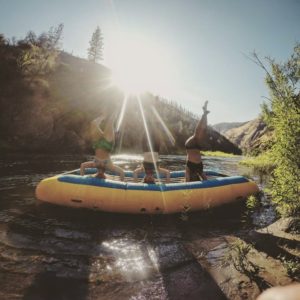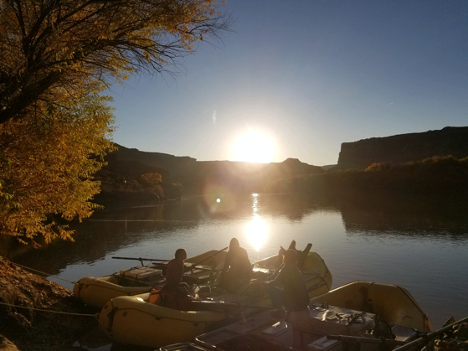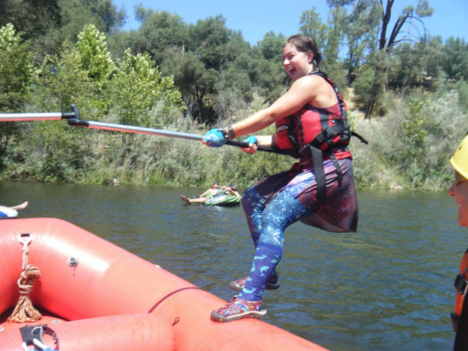Headwaters of River Conservation.
by Samara Rosen
 The American River used to be the place that my parents took my sisters and me to go kayaking. They used to boat without us, leaving me to lead the charge into the local “candy store” at the campground we stayed at. My sisters and I, licking our chocolatey fingers, would then wander down to the river banks and watch the brightly colored boats float by. We would stare, trying to figure out which kayakers were our parents. The telltale sign was their matching pink helmets. They would bop around the river bend smiling and smelling like wet neoprene.
The American River used to be the place that my parents took my sisters and me to go kayaking. They used to boat without us, leaving me to lead the charge into the local “candy store” at the campground we stayed at. My sisters and I, licking our chocolatey fingers, would then wander down to the river banks and watch the brightly colored boats float by. We would stare, trying to figure out which kayakers were our parents. The telltale sign was their matching pink helmets. They would bop around the river bend smiling and smelling like wet neoprene.- The river became a different place after the first time I paddled it. When I was nine, my parents let me run the river in an inflatable kayak with them. I splashed around in the front and my mom steered from the back. There is nothing like feeling the current grab you for the first time in its never-ending pursuit to reach the sea. My mom shouted tips from the back, “Look for the V in the rapids!” and then we would plunge into white chaos. The river became my source of adventure; my escape from elementary school, then middle school, then high school.
- When I graduated high school, I decided that I wanted to be a river guide and enrolled in guide school (a week-long guide training program) on the American River. As part of our training, the owner of the company, Scott Armstrong, told us a piece of the river’s cultural legacy. He described California’s first popular rafting run, the Stanislaus, and the old military bucket boats they dragged down the river. I was captivated by Scott’s description of the guides: people just a little older than I who knew every inch of the river canyon, not just because they rafted it every week but because in their time off, they explored. They hiked the length of the river, they lived in the caves, they detoured up every side creek, and then showed their clients these wonders. When the Stanislaus was threatened by the construction of a dam, many of these guides who knew what was at stake stepped up to fight on the river’s behalf. Scott had vivid descriptions of these guides, once smelly and unshaven, now navigating the world of op-eds and government official meetings and launching the river advocacy nonprofit Friends of the River. At night, instead of sleeping on rafts, they crammed into the floorspace of their office. They had one tactic that stuck with me: they lobbied public and government support by taking people down the river. The standing idea was that people would fight for the places they fell in love with.
- I graduated guide school and went on to become a full-time river guide; my relationship with the river changed once again. At first, I focused on remembering the steps to get clients through the rapids safely. River guides have a saying, “I know every rock on this river…because I have hit every rock on this river!” It’s true. I learned the many ways to run rapids by plunging into them on river boards, inner tubes, and even an inflatable swan pool toy in my free time. I could share unique games with clients because I myself was always finding new eddies to swim in and new rocks to slide down. Together, we got to play with the river. Before long, a flat boulder mid-river near my guide platform became my yoga rock; the river banks that gathered my coworkers every evening became the hub of my community. Through guiding, the river became my opportunity to live fully in each moment, my inner peace, my community, my teacher, my livelihood, and my home.
-
When I returned to college, one of my housemates asked me what I did over the summer. He looked disgusted as I told him. His response rang with the undertone of, “People are dying. The world is on fire. Why are you playing around?” I couldn’t find words, just an image of the Stanislaus River activists crowded together asleep on the office floor. What language could convey the purpose of knowing a river?
- I enrolled in classes to study rivers. I took notes on the CFS overallocated in the Colorado River and the degree to which climate change will impact freshwater distribution across the west. Rivers that I had never seen were reduced to numbers. CFS. Megawatts. Dam operation budgets. There was no representation for the world I had experienced over the summer. In my dreams, I returned to the river banks and the community I met there. That spring, I decided to leave school indefinitely.
- I enrolled in Friends of the River’s River Advocacy Training School. The RATS program, as it’s called, is an opportunity to study grassroots organizing and practice river advocacy in current river campaigns. This time, I took notes from personal heroes. My teachers sported deep Chaco tans (a classic river shoe) and talked about how to connect with people through a shared love of water, both over petitions and in government offices. Across the campfire, they talked about their own experiences of falling in love with these free-flowing places. We pitched advocacy talks on river trips so that our recipients could resonate with the river as a place, in addition to learning about how California rivers are often seen and used as resources.
- I returned to school with a perspective that academia needed to hear. For my college thesis, I chose to document the role of guiding in the river conservation movement and the relationship that river guides have to their rivers. I spent several months interviewing over fifty Stanislaus River activists and American River guides. Our interviews began with paperwork and my fumbling to start the recording device. Then we started talking about why we loved our rivers. Complete strangers told relatable stories of, “no shit, there I was…” and their process of learning to respect the river. I can vividly remember a guide leaning over his beer to tell me that he rafts every day because he loves it, but more so, he guides because he has something to share. I saw guides floating on the river under the full moon because even in their time off, they just want to be on the water. Overwhelmingly, guides talked about the importance of “exposure.” The idea that if you expose people to the value of rivers, they will be changed. I asked guides if they would get involved if the American River were threatened. The answer was a resounding, “Duh!”
- When I sat down at my computer to begin translating this way of knowing a river into academia, I saw a pattern throughout the dozens of rafting companies on the American River community and reaching as far back as the guides fighting for the Stanislaus. A shared understanding of the value of recreation that alluded my housemate but was perfectly clear to the decades upon decades of guides who had lived with the river for even just a season. A transformation that rerouted my entire academic career and perception of advocacy. A philosophy that Friends of the River was founded on and continues to uphold. That pattern is this: conservation is composed of people protecting the places they love. There are many ways to fall in love with a river, but one tried and true method is spending time with a river. You might even try to raft it.


